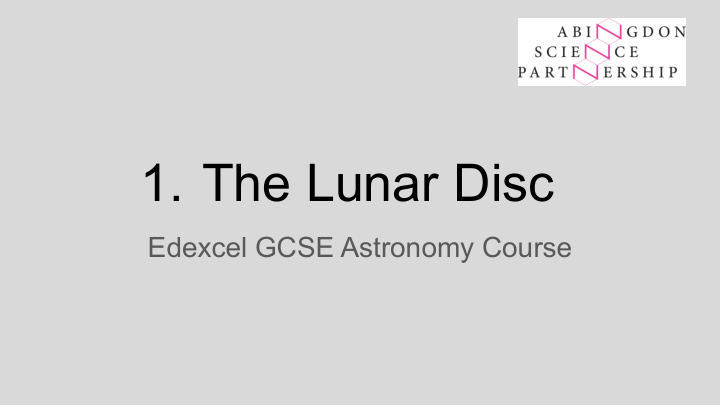



1. The Lunar Disc Edexcel GCSE Astronomy Course
2.1 Know the shape of the Moon 2.2 Be able to use information about the mean diameter of the Moon (3500 km) 1. The diameter of the Earth is 13000km. Calculate the ratio of Moon to Earth diameters. Try some calculation challenges using the mean diameter of the Moon: (d = 3500km) 2. Calculate the Moon’s circumference using 𝞺 d Calculate the surface area of the Moon using 4 𝞺 (d/2) 2 3. Calculate the volume of the Moon using 4/3( 𝞺 (d/2) 3 ) 4. 5. Calculate the volume of Earth estimate how many Moons would fit inside it
2.3 Be able to recognise the appearance of the principal naked-eye lunar surface formations, including: a craters b maria c terrae d mountains e valleys b maria a craters a craters s n i a e valleys t n u o m d c terrae
2.4 Understand the structure and origin of the principal naked-eye lunar surface formations, including: a craters b maria c terrae d mountains e valleys Write down definitions and explanations in two or three sentences using these sources: a craters https://astronmy.swin.edu.au/~smaddiso/astro/moon/craters.html b maria https://www.youtube.com/watch?time_continue=88&v=mIRPeYGKfic&feature=emb_logo 3 min video c terrae https://www.space.fm/astronomy/earthmoonsun/mariaterrae.html d mountains https://www.universetoday.com/145254/comparing-mountains-on-the-moon-to-the-earths-peaks/ e valleys https://www.space.fm/astronomy/earthmoonsun/valleys.html
2.5 Be able to identify the following features on the lunar disc: a Sea of Tranquility b Ocean of Storms c Sea of Crises d Tycho e Copernicus f Kepler g Apennine mountain range Learn the names and features then use the blank image on the next page to practise recalling them:
2.6 Be able to use the rotation and revolution (orbital) periods of the Moon 2.7 Understand the synchronous nature of the Moon’s orbit 2.8 Understand the causes of lunar libration and its effect on the visibility of the lunar disc Rotation rates and video: https://www.space.com/24871-does-the-moon-rotate.html Synchronous orbit: https://www.space.com/14808-moon-man-illusion-explained.html Libration basically means that the Moon appears to ‘wobble’ so we see a bit round one edge and a bit round the other, like peering round a corner - we can see more than 50% of its face from Earth: https://en.wikipedia.org/wiki/Libration https://solarsystem.nasa.gov/resources/2233/moon-phase-and-libration-2019/ https://www.lunarphasepro.com/what-is-lunar-libration/ Play the video! Yellow dot is sun; blue dot is Earth; play a moon orbit to see how sun angle changes so lunar month is 29.5 days. Libration is the apparent wobble due to both inclinations. Inclination is explained here: https://commons.wikimedia.org/wiki/File:Earth-Moon.PNG#/media/File:Earth-Moon.PNG Continued...
2.8 Understand the causes of lunar libration and its effect on the visibility of the lunar disc
Summary resources and videos about the Moon Read and watch these if you want to find out more: https://www.lpi.usra.edu/exploration/education/hsResearch/presentations/2011_2012/CamdenFairview.pdf https://www.nhm.ac.uk/discover/how-did-the-moon-form.html https://history.nasa.gov/SP-362/ch4.1.htm https://www.bbc.co.uk/programmes/articles/5gdrKwHtXhRkcq0xHDdhqvj/section-1-the-lunar-seas
Recommend
More recommend